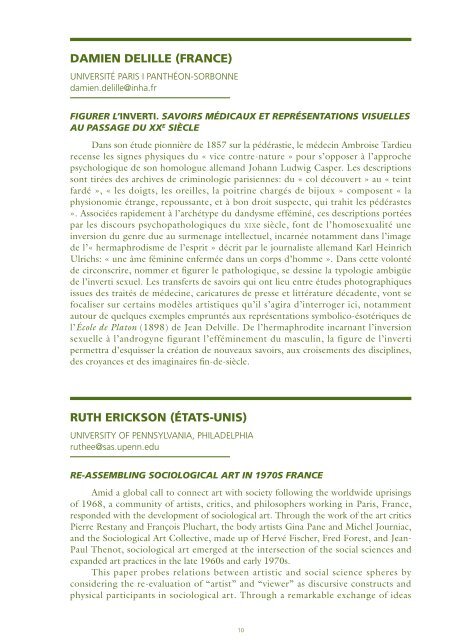COMMUNICATIONS - Réseau International pour la Formation à la ...
COMMUNICATIONS - Réseau International pour la Formation à la ...
COMMUNICATIONS - Réseau International pour la Formation à la ...
Create successful ePaper yourself
Turn your PDF publications into a flip-book with our unique Google optimized e-Paper software.
damien delille (FranCe)<br />
UNIVERSITÉ PARIS I PANTHÉON-SORBONNE<br />
damien.delille@inha.fr<br />
figurer L’inverti. saVoirs médicauX et représentations VisueLLes<br />
au passage du XX e siècLe<br />
Dans son étude pionnière de 1857 sur <strong>la</strong> pédérastie, le médecin Ambroise Tardieu<br />
recense les signes physiques du « vice contre-nature » <strong>pour</strong> s’opposer <strong>à</strong> l’approche<br />
psychologique de son homologue allemand Johann Ludwig Casper. Les descriptions<br />
sont tirées des archives de criminologie parisiennes: du « col découvert » au « teint<br />
fardé », « les doigts, les oreilles, <strong>la</strong> poitrine chargés de bijoux » composent « <strong>la</strong><br />
physionomie étrange, repoussante, et <strong>à</strong> bon droit suspecte, qui trahit les pédérastes<br />
». Associées rapidement <strong>à</strong> l’archétype du dandysme efféminé, ces descriptions portées<br />
par les discours psychopathologiques du xixe siècle, font de l’homosexualité une<br />
inversion du genre due au surmenage intellectuel, incarnée notamment dans l’image<br />
de l’« hermaphrodisme de l’esprit » décrit par le journaliste allemand Karl Heinrich<br />
Ulrichs: « une âme féminine enfermée dans un corps d’homme ». Dans cette volonté<br />
de circonscrire, nommer et figurer le pathologique, se dessine <strong>la</strong> typologie ambigüe<br />
de l’inverti sexuel. Les transferts de savoirs qui ont lieu entre études photographiques<br />
issues des traités de médecine, caricatures de presse et littérature décadente, vont se<br />
focaliser sur certains modèles artistiques qu’il s’agira d’interroger ici, notamment<br />
autour de quelques exemples empruntés aux représentations symbolico-ésotériques de<br />
l’École de P<strong>la</strong>ton (1898) de Jean Delville. De l’hermaphrodite incarnant l’inversion<br />
sexuelle <strong>à</strong> l’androgyne figurant l’efféminement du masculin, <strong>la</strong> figure de l’inverti<br />
permettra d’esquisser <strong>la</strong> création de nouveaux savoirs, aux croisements des disciplines,<br />
des croyances et des imaginaires fin-de-siècle.<br />
ruth eriCkson (états-unis)<br />
UNIVERSITy OF PENNSyLVANIA, PHILADELPHIA<br />
ruthee@sas.upenn.edu<br />
re-assembLing socioLogicaL art in 1970s france<br />
Amid a global call to connect art with society following the worldwide uprisings<br />
of 1968, a community of artists, critics, and philosophers working in Paris, France,<br />
responded with the development of sociological art. Through the work of the art critics<br />
Pierre Restany and François Pluchart, the body artists Gina Pane and Michel Journiac,<br />
and the Sociological Art Collective, made up of Hervé Fischer, Fred Forest, and Jean-<br />
Paul Thenot, sociological art emerged at the intersection of the social sciences and<br />
expanded art practices in the <strong>la</strong>te 1960s and early 1970s.<br />
This paper probes re<strong>la</strong>tions between artistic and social science spheres by<br />
considering the re-evaluation of “artist” and “viewer” as discursive constructs and<br />
physical participants in sociological art. Through a remarkable exchange of ideas<br />
10



